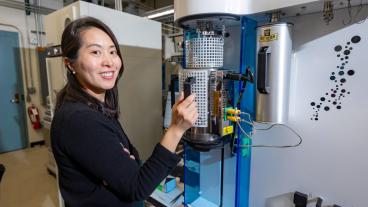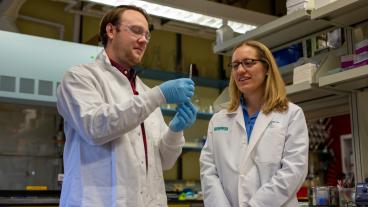A Mines assistant professor of chemical and biological engineering is working to make the use of biofuel more viable for the U.S. military, particularly the Navy, with help from undergraduate and PhD students.
The Navy aims to generate 50 percent of its energy from alternative sources by 2020 – this includes nuclear energy, electricity from renewable sources, and biofuels. This goal can only be met, said C. Mark Maupin, “if we can surmount some daunting issues.”
First of these is the fact that microorganisms found in nature – and essentially every fuel storage tank and pipeline – will consume both petroleum-based liquid fuel and biofuels using them as a primary carbon source. Although the loss of fuel itself is not the biggest problem, Maupin said, “The microorganisms can cause the fuel to go ‘bad,’ and the presence of the microorganisms and the associated biofilms they produce are linked to corrosion of the fuel storage containers and pipelines.”
The Navy has already had a serious issue with microbial-induced biocorrosion in their compensated fuel ballast tanks, leading to costly maintenance, and is concerned about the impact of new biofuels on the rate of storage tank corrosion. Maupin, his former PhD student Vivek Bharadwaj, and Anthony Dean, formerly a professor in the CBE department and currently vice president for research at Mines, are part of the Office of Naval Research Multidisciplinary University Research Initiatives team looking into the problem, focused particularly on the ability of microorganisms to use biofuels as food.
The Mines group also includes two undergraduate students who have worked in Maupin’s lab over two consecutive summers via Research Experiences for Undergraduates funding – Nathaniel Eagan and Nicholas Wang.
The group’s work was first featured in the Journal of the American Chemical Society in 2013, focusing on one of the first steps that microbes take to digest the fuel. Using two enzymes – benzylsuccinate synthase and alkylsuccinate synthase – the microbes turn the fuel into something they can use as a building block for molecules such as fatty acids. The paper details the first creation of a homology model for one of the enzymes and provides molecular-level insights into the mechanism behind this reaction, which adds a fumarate molecule to the fuel.
A second paper, published in the journal Physical Chemistry Chemical Physics in February of this year and featured on its back cover, looked at the impact of different hydrocarbon structures on the energetics and kinetics of the fumarate addition.
Maupin’s group was most recently published in the journal Chem Phys Chem and featured on the inside cover for a separate, but related project. The paper details the work they’ve done to evaluate certain properties of biodiesel, which is made up of fatty acid methyl esters (FAMEs), which are the primary component in biodiesels.
A typical biodiesel – created from algae or other lipid sources – is actually composed of different types of FAMEs, varying in carbon tail length and the amount of double bonds in the tail. These variations impart various properties on the liquid fuel, such as density, viscosity, diffusion rates, crystal formation characteristics, and cloud point. Maupin and his team have been simulating different FAMEs and multiple biodiesel mixtures to identify the components necessary for creating desired characteristics in the fuel.
“In the end, we want to use both projects to create the next-generation biodiesel,” Maupin said.
Contact:
Mark Ramirez, Information Specialist, College of Applied Science & Engineering | 303-384-2622 | ramirez@mines.edu
Karen Gilbert, Director of Public Relations, Colorado School of Mines | 303-273-3541 | kgilbert@mines.edu



